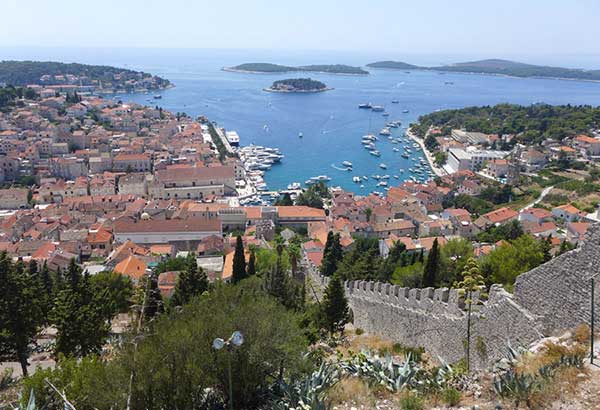Croatia, crazy about ya!

Hvar has an articulated coastline, 300 meters long. Its principal trading product was salt, truly worth its weight in gold.
Captivating Croatia, with 1,200 islands and a 1,277-kilometer coastline, shares the Adriatic Sea with Italy. Actually, people take their vehicles with them and use the ferries that regularly sail between the two countries.
Croatia has a mottled, battle-scarred history, always controlled by the powerful Venetians and constantly threatened by the Ottoman Empire; they were even attacked by their neighbor, Serbia. The Croats were the soldiers, fighting for another country, but not for their own. It is this colorful past that has left the islands with Roman ruins, medieval fortresses and castles, and numerous churches (the majority are Catholics), which are beautifully preserved.
(Trivia: the French word “cravat” evolved from the word “Croat.” During the Thirty Years’ War [1618-1648] the Croatian soldiers identified themselves by wearing colorful scarves tied in a certain way, around their necks. Apparently, the practice caught on — a la manière croat, in the Croatian way.)
The Italian influence is seen in the buildings, food, and the people themselves. Croatians, aside from their native language, speak English and Italian. Most of the signs are in Croatian and Italian.
Croatia — with Bosnia-Herzegovina, Serbia, Slovenia, Macedonia and Montenegro — was part of the federation that comprised Yugoslavia. Today, Croatia is an independent socialist republic.
Active fishing (delicious seafood!) and seafaring industries exist here. Ferry boats, sailboats, and yachts transport people and produce from one island to the next. Tourism, though, is the one industry that has been growing quickly. There are airports in Dubrovnik and Zagreb, Croatia’s capital, but only smaller sea vessels can approach its many interesting islands.
Because of Istria’s rich soil, this Croatian region’s industries revolve around truffles, wine, and olive oil. Motovun, a12th-century Istrian town, is 270 meters above sea level and gives a magnificent view of a truffle forest, where they use dogs to sniff the precious tuber. It is an uphill cobble-stoned trek to the town center.
It is interesting to learn that an annual indie film festival has been held here for the last 20 years. So, for one week, movie folks — including Ken Russell and Vanessa Redgrave — from all over the world come to this tiny fortress town and fill up its meager hotels. Also, Mario Andretti, famous racing legend, was born in Motovun — a plate on a residence says so.
There are seven active cloistered monasteries in Croatia. The Benedictine Monastery of St. Nicholas in Trogir, established in 1064, has existed for almost a thousand years and has continuously influenced the spirituality of the people. Nuns run the museum where beautiful reliquaries of saints are displayed. The portal of the Cathedral of Saint Lawrence displays an intricately carved story of the birth until the death of Christ and a visual calendar of the seasons of the year. Since the people could not read, this was the way they were educated about religion.
Split, the second largest city in Croatia, started as a Greek settlement in the 2nd century and became the capital of the Roman province of Dalmatia. (Another trivia: Dalmatian dogs come from here. On the nights before an attack by the Ottoman army, these dogs were released to bite the enemy’s horses and render them useless.)
Emperor Diocletian decided to retire in Split because of its proximity to sulfuric water for his rheumatism. The massive three-hectare, fortified palace he built in the 4th century still stands today, and is a Unesco World Heritage site. (We were told that he was the persecutor of Christians; that 50 percent of the saints were executed by him.) When the next emperor, Constantine, came to power, all of the statues of Diocletian were destroyed.
Korcula, dubbed “little Dubrovnik,” is just as charming, but with fewer tourists. It has colorful buildings on narrow, cobblestoned streets. It is said that Marco Polo, the explorer, may have been born here. His house is marked, but also a lot of restaurants and souvenir stores bear his name. The streets are interestingly in the shape of a herringbone, planned so that the wind flows freely into its buildings. At its heart is St. Mark’s Cathedral, built in the 14th-16th centuries, and is dedicated to its patron saint and protector.
Dubrovnik’s old town itself is a Unesco World Heritage site. It is surrounded by a two-kilometer, well-preserved, completely walkable wall, built between the 8th and 16th centuries, to keep the Ottomans and all other would-be attackers at bay. Its defenses have never been breached, maintaining its maritime power in the 15th to 16th centuries.
The walk on the wall is exhilarating. The coral-color rooftops are framed by massive structures, gated with dramatic drawbridges. Yes, it is quite a worthy setting for Game of Thrones!
While Dubrovnik is the most popular destination in Croatia, its islands are so captivating that it could be well-worth hiring one’s own yacht to visit them.
* * *
Tell me where to walk the talk: cecilialicauco2@gmail.com. Follow me on Instagram: cecilialicauco2 Photos by Cecilia Licauco



















